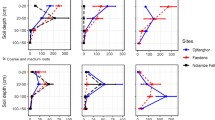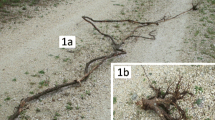Abstract
Almost nothing is known about the vertical root distribution for Himalayan forest trees. By providing an analysis of vertical distribution of root density of ten important central Himalayan tree species (two evergreen conifers, five evergreen broadleaf species and three deciduous broadleaf species), this paper attempts to address this gap. We used trench profile method to measure tree root density, both of fine (≤ 3 mm diameter) and coarse (> 3 mm diameter) roots. Principal Component Analysis was performed to identify the major sources of variation among species in root distribution. In ten study tree species (eg., sal, oaks, pine and Cupressus torulosa) the rooting depth varied from 90 to 150 cm. On average across the study species, about 49% total roots (all diameter classes) occurred below 30 cm depth and 20.6% below 60 cm depth. These percentages are almost identical to that of tropical rain forest of Amazon. The tree species varied in root density (in entire soil column) from 26.04 ± 2.66 root/100 cm2 in Q. floribunda to 52.7 ± 4.96 root/100 cm2 in Machilus duthei. The ordination graph indicated that tree species of a growth form and even a genus did not form groups and differed markedly in root characters. Tree water status and roots were related only partially and in a complex way. The study has shown that (1) root density measured by digging trenches gives a reasonable estimate of proportional root distribution of trees, and (2) studies which consider only top 30 cm depth can grossly misrepresent root distribution and its consequence.






Similar content being viewed by others
References
Agren GI, Axelsson B, Flower-Ellis JG, Linder S, Persson H, Staaf H, Troeng E (1980) Annual Carbon budget for a young scots pine. Ecol Bull 32:307–313
Aragão LE, Malhi Y, Metcalfe DB, Silva-Espejo JE, Jiménez E, Navarrete D, Almeida S, Costa AC, Salinas N, Phillips OL, Anderson LO, Alvarez E, Baker TR, Goncalvez PH, Huaman-Ovalle J, Mamani-Solorzano M, Meir P, Monteagudo A, Patino S, Penuela MC, Prieto A, Quesada CA, Rozas-Davila A, Rudas A, Silva JA Jr, Vásquez R (2009) Above-and below-ground net primary productivity across ten Amazonian forests on contrasting soils. Biogeosciences 6:2759–2778
Bisht H, Nain AS, Gautum S, Puranik HV (2013) Agro-climatic zonation of Uttarakhand using remote sensing and GIS. J Agrometerol 15:30–35
Bloom AJ, Chapin FS, Mooney HA (1985) Resource limitation in plants-an economic analogy. Annu Rev Ecol Syst 16:363–392
Bohm W (1979) Methods of studying root systems. Springer, Heidelberg
Champion HG, Seth SK (1968) A revised survey of forest types of India. Govt. of India Press, New Delhi
Clark DA, Brown S, Kicklighter DW, Chambers JQ, Thomlinson JR, Ni J (2001) Measuring net primary production in forests: concepts and field methods. Ecol Appl 11:356–370
Cordeiro AL, Norby RJ, Andersen KM, Valverde-Barrantes O, Fuchslueger L, Oblitas E, Hartley IP, Iversen CM, Goncalves NB, Takeshi B, Lapola DM, Quesada CA (2020) Fine-root dynamics vary with soil depth and precipitation in a low-nutrient tropical forest in the Central Amazonia. Plant-Environ Interact 1:3–16
Elliot ET, Coleman DC (1988) Let the soil work for us. Ecol Bull 39:23–32
FAO (2020) Global Forest Resources Assessment – Main report, Rome
Gahlot T, Joshi P, Rawat YS (2020) Stand structure and regeneration status of tree species in four major forest types along an altitudinal gradient in Kumaun Himalaya, Uttarakhand. Trop Plant Res 7:176–189
Gotelli NJ, Ellison AM (2004) A primer of ecological statistics. Sinauer Associates, Inc., Sunderland, p 510
Helmisaari HS, Makkonen K, Kellomaki S, Valtonen E, Malkonen E (2002) Below-and above-ground biomass, production and nitrogen use in Scots pine stands in eastern Finland. For Ecol Manage 165:317–326
Iversen CM (2010) Digging deeper: fine-root responses to rising atmospheric CO2 concentration in forested ecosystems. New Phytol 186:346–357
Iversen CM, McCormack ML, Powell AS, BlackwoodCB FGT, Kattge J, Roumet C, Stover DB, Soudzilovskaia NA, Valverde-Barrantes OJ, Van Bodegom PM, Violle C (2017) A global fine-root ecology database to address below-ground challenges in plant ecology. New Phytol 215:15–26
Jackson RB, Canadell J, Ehleringer JR, Mooney HA, Sala OE, Schulze ED (1996) A global analysis of root distributions for terrestrial biomes. Oecologia 108:389–411
Joshi R, Sambhav K, Singh SP (2018) Near surface temperature lapse rate for treeline environment in western Himalaya and possible impacts on ecotone vegetation. Trop Ecol 59:197–209
Lozanova L, Zhiyanski M, Vanguelova E, Doncheva S, Marinov MP, Lazarova S (2019) Dynamics and vertical distribution of roots in European Beech forests and Douglas Fir plantations in Bulgaria. Forests 10:1123
Lukac M (2012) Fine root turnover. In: Mancuso S (ed) Measuring roots. Springer, Berlin, Heidelberg, pp 363–373
Magrin GO, Marengo JA, Boulanger JP, Buckeridge MS, Castellanos E, Poveda G, Scarano FR, Vicuna S (2014) Central and South America. In: Barros VR, Field CB, Dokken DJ, Mastrandrea MD, Mach KJ, Bilir TE, Chatterjee M, Ebi KL, Estrada YO, Genova RC, Girma B, Kissel ES, Levy AN, MacCracken S, Mastrandrea PR, White LL (ed) Climate change: Impacts, adaptation, and vulnerability. Part B: Regional aspects. Contribution of Working Group II to the Fifth Assessment Report on the Intergovernmental Panel on Climate change. Cambridge University Press, Cambridge, New York, pp 1499–1566
Matamala R, Gonzalez-Meler MA, Jastrow JD, Norby RJ, Schlesinger WH (2003) Impacts of fine root turnover on forest NPP and soil C sequestration potential. Science 302:1385–1387
McCormack ML, Dickie IA, Eissenstat DM, Fahey TJ, Fernandez CW, Guo D, Helmisaari HS, Hobbie EA, Iversen CM, Jackson RB, Leppalammi-Kujansuu J, Norby RJ, Phillips RP, Pregitzer KS, Pritchard SG, Rewald B, Zadworny M (2015) Redefining fine roots improves understanding of below-ground contributions to terrestrial biosphere processes. New Phytol 207:505–518
Metcalfe DB, Meir P, Aragão LE, da Costa AC, Braga AP, Gonçalves PH, Junior J de AS, de Almeida SS, Dawson LA, Malhi Y, Williams M (2008) The effects of water availability on root growth and morphology in an Amazon rainforest. Plant Soil 311:189–199
Miehe G, Pendry CA, Chaudhary RP (eds) (2015) Nepal: An Introduction to the Natural History, ecology and human environment of the Himalayas. Royal Botanic Garden, Edinburgh
Mokany K, Raison RJ, Prokushkin AS (2006) Critical analysis of root:shoot ratios in terrestrial biomes. Glob Change Biol 12:84–96
Ostonen I, Puttsepp U, Biel C, Alberton O, Bakker MR, Lohmus K, Majdi H, Metcalfe D, Olsthoorn AF, Pronk A, Vanguelova E, Weih M, Brunner I (2007) Specific root length as an indicator of environmental change. Plant Biosyst 141:426–442
Persson H (1979) Fine root production mortality and decomposition in forest ecosystem. Vegetatio 41:101–109
Pierret A, Maeght JL, Clément C, Montoroi JP, Hartmann C, Gonkhamdee S (2016) Understanding deep roots and their functions in ecosystems: an advocacy for more unconventional research. Ann Bot 118:621–635
Pregitzer KS (2002) Fine roots of trees-a new perspective. New Phytol 154:267–273
Rewald B, Rechenmacher A, Godbold DL (2014) It’s Complicated: Intraroot system variability of respiration and morphological traits in four deciduous tree species. Plant Physiol 166:736–745
Russell AE, Cambardella CA, Ewel JJ, Parkin TB (2004) Species, rotation, and life-form diversity effects on soil carbon in experimental tropical ecosystems. Ecol Appl 14:47–60
Sahni KC (1990) Gymnosperms of India and Adjacent Countries. Bishen Singh Mahendra Pal Singh, Dehradun
Schenk HJ, Jackson RB (2002) The global biogeography of roots. Ecol Monogr 72:311–328
Singh SP (2018) Research on Indian Himalayan treeline ecotone: an overview. Trop Ecol 59:163–176
Singh SP, Singh JS (1992) Forests of the Himalayas: structure, function and impact of man. Gyanodaya Prakashan, Nainital
Singh SP, Zobel DB, Garkoti SC, Tewari A, Negi CM (2006) Patterns in water relations of central Himalayan trees. Trop Ecol 47:159–182
Singh SP, Tewari A, Phartiyal P (2011) Community Carbon forestry to counter forest degradation in Indian Himalayas. In: Skutsch MM (ed) Community forest monitoring for the carbon market. Opportunities Under REDD. Earthscan, pp 118–133
Singh SP, Singh RP, Gumber S, Bhatt S (2017) Two principal precipitation regimes in Himalayas and their influence on tree distribution. Trop Ecol 58:679–691
Steele SJ, Gower ST, Vogel JG, Norman JM (1997) Root mass, net primary production and turnover in aspen, jack pine and black spruce forests in Saskatchewan and Manitoba, Canada. Tree Physiol 17:577–587
Strand AE, Pritchard SG, McCormack ML, Davis MA, Oren R (2008) Irreconcilable differences: fine-root life spans and soil carbon persistence. Science 319:456–458
Troup RS (1921) The Silviculture of Indian Trees. Vol III Lauraceae to Coniferae. Oxford University Press, Oxford
Usman S, Rawat YS, Singh SP, Garkoti SC (1997) Fine root biomas production and turnover in evergreen forests of Central Himalaya, India. Oecol Mont 6:4–8
Vogt KA, Moore EE, Vogt DJ, Redlin MJ, Edmonds RL (1983) Conifer fine root and mycorrhizal root biomass within the forest floors of Douglas-fie stands of different ages and site productivities. Can J For Res 13:429–437
Vogt KA, Publicover DA, Bloomfield J, Perez JM, Vogt DJ, Silver WL (1993) Belowground responses as indicators of environmental change. Environ Exp Bot 33:189–205
Yanagisawa N, Fujita N (1999) Different distribution patterns of woody species on a slope in relation to vertical root distribution and dynamics of soil moisture profiles. Ecol Res 14:165–177
Yao T, Thompson L, Yang W, Yu W, Gao Y, Guo X, Yang X, Duan K, Zhao H, Xu B, Pu J, Lu A, Xiang Y, Kattel DB, Joswiak D (2012) Different glacier status with atmospheric circulations in Tibetan Plateau and surroundings. Nat Clim Change 2:663–667
Zobel DB, Singh SP (1997) Himalayan forests and ecological generalizations. Bioscience 47:735–745
Acknowledgements
All the authors acknowledge the research facilities provided by Central Himalayan Environment Association (CHEA), Nainital (Uttarakhand), India and Indian National Science Academy to provide Honorary Scientist Fellowship to one of the author (SPS). AT and RDS are grateful to Department of Forestry and Environmental Science, DSB Campus, Kumaun University; and RP to Indian Council of Forestry Research and Education (ICFRE) for liberal support.
Author information
Authors and Affiliations
Corresponding author
Rights and permissions
About this article
Cite this article
Pathak, G.C., Joshi, H., Singh, R.D. et al. Vertical root distribution in Himalayan trees: about half of roots occur below 30 cm, the generally sampled depth. Trop Ecol 62, 479–491 (2021). https://doi.org/10.1007/s42965-021-00159-0
Received:
Revised:
Accepted:
Published:
Issue Date:
DOI: https://doi.org/10.1007/s42965-021-00159-0




